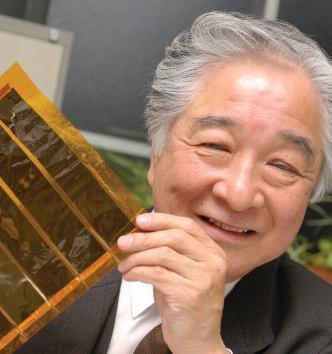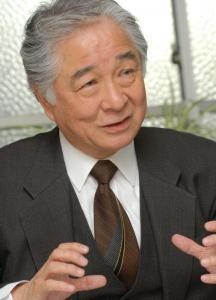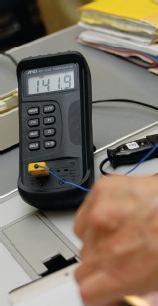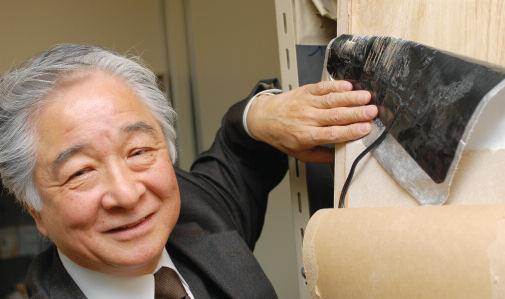Hisashi Misawa’s "Germ Heat"
Heating everything at half the cost
By Burritt Sabin
Traveling northeast from Naka-Meguro (a Tokyo station) on the Hibiya Line you reach a sartorial watershed. The yonder side of Higashi Ginza the men in Burberry suits and women in Prada have vanished, and workers in overalls and seniors with small shopping carts fill the car. You have passed through the business and fashion centers and are moving into the Shitamachi, the eastern quarter, where Old Edo is said to survive. Indeed this low-lying district along the Sumida River is home to the sumo arena, the city’s liveliest festivals, public baths and cottage industries. In the last named labor the shokunin (the artisans) fashioned things with pride and stubborn persistence.
A short walk from Naka-okachimachi Station, between Akihabara and Ueno on the Hibiya Line, in the heart of the Shitamachi, is the office of Hisashi Misawa. The location fits the man. He is a maker of things.

Misawa bounds into the room on the third floor of the pencil-narrow building. Only his shock of white hair gives away his 66 years. We have come to learn about his Germ Heater. He bubbles with enthusiasm as he explains.
He begins by recounting his brainstorm. Back in the mid-1990s a fire broke out at a semiconductor plant. Heat from a part had ignited a cleansing gas. In the aftermath, Misawa was asked if he could develop parts that generated less heat. The request sparked an idea. He knew, of course, that semiconductors give off heat, that is why transistors get hot, and personal computers. When a PC is in use, the electric current passing through its semiconductors and other parts, process information but also generate heat so an exhaust fan is needed. If the heat is not expelled, the data-processing function would be degraded.
Misawa focused on Germanium, a grayish-white element with a metallic luster and electrical properties between those of a metal and an insulator, which is to say, it is a semiconductor. Semiconductors are found in televisions, remote controls and other devices used in daily life.
He began researching and developing a heater utilizing what, until now, had been a semiconductor waste product, heat. He succeeded in generating heat through an application of a small amount of electricity to a semiconductor. What’s more, he was able to regulate the temperature. He called his heater "Germ Heat" after Germanium, one of its principal materials. It uses half of the electricity of conventional electric heaters, Germ Heat is an epoch-making power source. Misawa exhibited a prototype at a trade fair in 2000.

Misawa takes a piece of black polymide film connected to an electric cord, he plugs the cord into an outlet atop a large table and invites us to touch the film. It is warm. “It heats up in a jiffy,” he beams. He performs this simple demonstration with boyish verve. Indeed, with respect to the joy of handson creation, the child still dwells in the man.
Hisashi Misawa was born in 1941 in Jinan, in the northwestern part of Shandong Province, China, where his father worked for the Japanese National Railways. After the war the family repatriated, taking up residence in Kobe. Hisashi attended the city’s public schools. What distinguished him from other kids was a fascination with electricity. In the third grade he built a battery-operated three-story elevator for submission to a Hyogo Prefecture competition. He won first prize. Needless to say, when he matriculated at Osaka University, he selected electrical engineering as his major.
Germ Heat can be adjusted for temperatures from 30 to 200 degrees, depending on the purpose. But is it safe? Although capable of generating high temperatures, it does not autoignite or release gas, explains Misawa. For these reasons it has found wide application in industry, for example, in heating railway cars and livestock pens and in preventing pipes from freezing.
Germ Heat is the achievement of a long career in which Misawa has followed his muse. This has made him something of a maverick in Japan.
We are skeptical. How can film be heated to 200 degrees without igniting? Misawa hurries to a lower floor and returns with a lighter and ash tray. A cigarette break? No, he cuts a strip of polymide film used to embed the Germ Heater and holds it over the ash tray. He puts its tip in the lighter’s flame, it doesn’t burn. Products are designed with films ranging from 30 to 200 degrees centigrade in maximum temperature. The film version of Germ Heat can produce a temperature of 280 degrees, although Misawa has yet to develop a product requiring such a high temperature.

Next he places atop the ashtray a white ceramic slate embedded with Germ Heat. He attaches alligator clips and turns up the juice, a burnt smell reaches our nostrils, suggesting high temperature. Tempted to touch the slate, he warns us not to, the ceramic is too hot to handle. To re-emphasize the safety of his invention, he sets a scrap of paper onto the plate, it doesn’t burn. We think it should have gone up in smoke. He notices our puzzlement and explains, “Oxygen is required for combustion. No oxygen is being consumed, so there is no fire.” We sheepishly recall the fire triangle we were taught in school. Yes, one side was oxygen to sustain combustion. We all agree that the ceramic Germ Heat would be ideal for heating that necessity of Japanese daily life, the bathtub, or even a swimming pool. The ceramic Germ Heat can generate temperatures up to 450 degrees.
Germ Heat is the achievement of a long career in which Misawa has followed his muse. This has made him something of a maverick in Japan.
His muse first
Upon graduation from university, Misawa joined Hitachi Ltd.’s research laboratory in Kokubunji, Tokyo, in 1964, the year of the Tokyo Olympics. He was assigned to the development of basic technologies for electric power plants. He was, however, interested in electronic calculators rather than power plants. He asked for a transfer and was refused. He said sayonara. Most young engineers would have stayed. It was an era of high economic growth and blue chips, like Hitachi, guaranteed employment for life except Misawa is an engineer who has been guided by his muse. Job security has been second.
Through a newspaper advert he landed a job in the Communications Department of Oki Electric Industry Co., Ltd. The job gave him the opportunity to learn about semiconductors and light electrical appliances. He was involved in design and production. He happily immersed himself in the splendid culture of making things.
The muse knocked again. With the development of the microprocessor in the first half of the 1970s, computers busted out of the narrow world of university, government agency and other well-endowed institutions. It was an exciting time in computing and Misawa was introduced to the computer through his work with semiconductors. He then wanted to build one.
However, his department focused on production of special acoustic equipment and communication equipment. Around that time Misawa had made the acquaintance of a Matsushita Electric Industrial Co., Ltd. rep who often visited Oki Electric’s Communication Department. The rep wanted to launch a company to build a computer and needed an engineer, was Misawa interested?
He asked his boss at Oki Electric whether he could work in semiconductors in the future. No, he was told, so, after 11 years with the company he left.
The erstwhile Matsushita rep, Misawa and another formed Tokyo Tokki Co., Ltd. to design and manufacture computers. They employed a staff of four. The company handled design, fabrication, manufacture and sales, using subcontractors to turn out about 10 sets a year.
Misawa was a director of Tokyo Tokki for approximately four years. One of the computers they built, in the late 1970s, is still in use at a garbage disposal facility. When its employees insert a punch card in the machine, a red destination board tells them the number of the truck and their job— driver, co-driver, or collector—that morning. The facility can’t upgrade their computer system for lack of budget, laughs Misawa. Besides, collection teams are accustomed to the present system.
A friend of Misawa’s was the son of the President of Asahi Tsushin Kogyo, whose principal client was Nippon Telegraph and Telephone (NTT), a public corporation with a monopoly of the Japanese telecommunications market. The President confided to his son that the age of reliance on NTT was over (indeed, it would be privatized in 1985 to foster competition), and they must look beyond telecommunications. Misawa heard what the President was thinking from his friend, which in subsequent events, led onto him being asked to join Asahi Tsushin.
A major factor in this move was that his former company Tokyo Tokki’s business had come from local governments, but municipalities began to outsource; there was little potential for growth. What’s more Misawa, the engineer, had never been completely comfortable with his two fellow directors, whom he regarded as creatures of the business world. He wanted to pursue technical projects, so he nurtured an engineer to replace him. If you run into difficulties, I can pitch in and help, he told them. Having passed the baton, he entered Asahi Tsushin Kogyo. Misawa remained there for about two years and left to become director of Asahi Denshi Kogyo in January 1981. Today he is its President.
An Inimitable Invention
Misawa is quick to sing the praises of Germ Heat. He has already demonstrated its safety. Next he points out that because the molecular structure is a stability mechanism, the speed of the temperature rise is fast and the temperature is always constant. Then there is the wide applicability arising from Germ Heat’s being in the form of a polymide tape. It varies in thickness, from 0.24 to 0.64mm, according to the desired temperature range. The film can be wound or folded, allowing for the manufacture of lightweight, compact products. It can be tailored to the intended use by giving consideration to such points as dimensions, voltage and desired temperature during design, also it can run on 3 to 400 volts DC or AC and be powered by a battery when used in a mobile mode.
He points to a Germ Heat floor heating device propped against the wall, beside it is a conventional floor heating device. “Our floor heating uses 20% less electricity,” says Misawa. Other applications include a hot plate, space heater, bread oven, a laver roaster (a very Japanese product) and a panel heater, which is, the first Germ Heat consumer product Misawa is marketing in a big way from this Spring.

Misawa has filed a patent application for Germ Heat, but Japan’s Patent Office is notoriously slow, he figures he will have to wait another year for approval. Meanwhile representatives from Japan’s electronic giants have beaten a path to his Shitamachi office. He demonstrates Germ Heat’s ‘magical properties’ for them. He always obliges requests for a morsel of Germ Heat film as a souvenir, although he knows full well the samples will be deconstructed and analyzed by engineers at some of the most advanced R&D institutes in Japan. With a patent pending, but not in hand, their unlocking the secret of Germ Heat would seem cause for worry. Misawa, however, is unfazed and says “They have never figured out how Germ Heat works.”
How could they? Germ Heat is the fruit of the experience and knowledge Hisashi Misawa has gained ever since his toy elevator rose three stories to first place in the competition in Hyogo Prefecture nearly 60 years ago.
While Germ Heat can produce controllable heat at half of the electric consumption of traditional heaters, Germ Heat products can cost as much as 20% more, although the added expenditure can be recouped in a year in smaller electric bills. The reason for the high cost is that Asahi Tsushin Kogyo does not derive the benefits of economies of scale from mass production. Misawa is eager to attract investors to fund a full-scale roll out of Germ Heat consumer products.
His following, his muse, should prove good for the environment and profitable for him and any partners. This maverick engineer can be reached at the address below. JI
President: Hisashi Misawa
Asahi Denshi Kogyo Co. Ltd
4-18-7 Taito, Taito-ku, Tokyo 110-0016
Tel: 03-3833-2231
Email: info@japaninc.com





